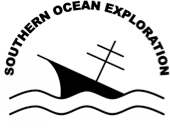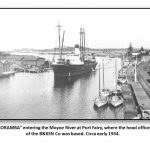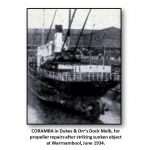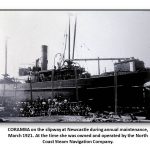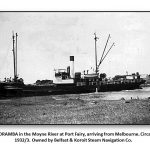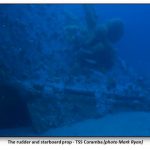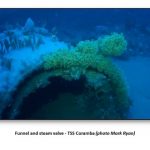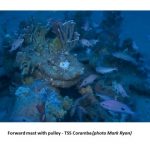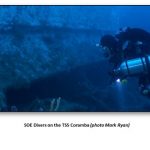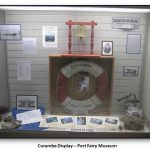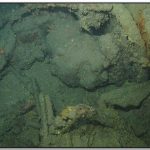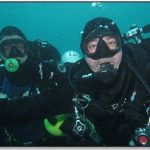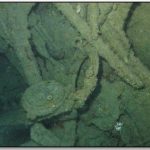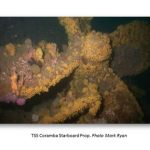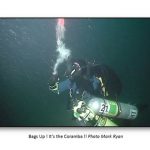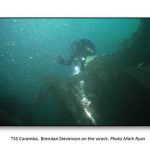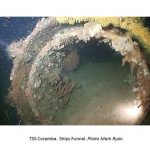TSS Coramba
The TSS Coramba was a 531 ton twin screw steamer owned by the Belfast and Koriot Steamship Company. The Coramba was used primarily for shipping freight between Port Fairy and Melbourne. On the 29th November 1934 at 1:00pm the Coramba left Warrnambool for Melbourne. She was due to arrive at 7:00am the following day but was never seen again. At the time it was believed that the Coramba sank in a fierce gale off Phillip Island on the approach to Western Port on 30th November 1934 at approximately 10:30pm.
The wreck was originally reported as being located in December 1934 by the famous diver Johnno Johnstone on request of the Coramba’s insurance company. However the wreck was never dived and its actual location was not confirmed. It was thought to be near Seal Rocks Phillip Island. In 1984 Des Williams authored the Book “The Ship the Sea Swallowed”. This document contains details of the ships history and its sinking. Other resources used include The Board of Marine Inquiry into the sinking. Additional information was also gathered from the National Archives, personal interviews and Newspapers. After 7 years of searching the TSS Coramba was discovered by SOE on the 29th May 2011 approximately 10 nautical miles south of Seal Rocks, a long way from all other indicated positions. Whilst finding the ship answers the immediate mystery as to the location of the wreck, there are still many unanswered questions as to the ships final moments. Over the coming months SOE will continue to explore and document this shipwreck site in an effort to resolve the final questions of this tragic story.
Ships Construction
Description: Twin Screw Steamer .
Trial Date: 9th October, 1911. Weather: Calm. Speed: 10.85 knots at 163.25 revolutions.
Length: 160 feet. Breadth: 30 feet Depth: 10 feet
Displacement: 531 tons. Cargo Capacity: 402 tons. Hold Capacity: 26,760 cubic feet. One Deck. Four Bulkheads. Two Holds.
Registered Horse Power: 73.
Style of Engines: Twin, reciprocating, direct acting, compound, vertical inverted steam. Four cylinders, 14″ x 30″ x 18″ stroke, 73HP. Boiler: One cylindrical, multitubular, single ended, steel, 135 lb pressure. 13’3″ x 11′.
Propellers: Four Blades. Diameter & Pitch: 6 feet 6 inch x 8 feet.
Lifeboats: Two, 20 ft. x 6 ft. 6 inches x 2 ft. 9 inches.
No. of Passengers: 1st Class -one spare room.
No. of Officers: Captain, 1st and 2nd Officers, Chief Engineer, and 2nd Engineer
No. of Crew: Cook, Cabin Boy and twelve seamen.
Rig: Fore and aft schooner. Masts: Two pole masts (steel). Weight: 1.6 tons.Electric Light: Gelford, Grier & McKay. ,
Builders: Ailsa Ship-Building Co. Ltd., Troon, Ayrshire, Scotland.

Ship Owners
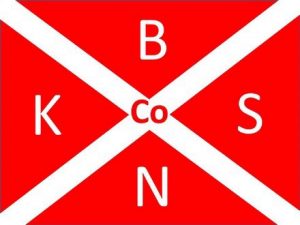

The Final Voyage
On what was to be her final voyage, the Coramba left Warrnambool at 1.00pm on Thursday 29th November after having previously loaded cargo at Portland and Port Fairy. The cargo consisted of wool, shell grit and condensed milk. She was due to arrive at Port Phillip heads at 4:00am the following day, and 3 hours later in Melbourne.By night fall the crew of the Coramba would have been alarmed at the rapidly falling barometer and the increasing swell from the south west. A low pressure system of this magnitude would drive up a huge swell ahead of it giving warning of the oncoming gale. Around midnight of the 29th a massive low pressure system moved into Bass Strait forming one of the worst storms Victoria had ever seen. Rounding Cape Otway and sailing onto to Port Phillip Heads the Coramba encountered extremely violent seas and in the pitch black of night this would have been of great concern for the Captain and crew.By daybreak the storm was in full force and Port Phillip Heads was impassable. Much havoc was wreaked across the state of Victoria with significant flooding, property destruction and loss of life.The Coramba may have arrived at Port Phillip heads sometime in the early morning of the 30th. Being dark and in the midst of such a terrible storm it would have been suicide to attempt the crossing of the Port Phillip entrance. It appears Captain Dowling had taken the Coramba further east to Western Port Bay to seek shelter until the weather abated. There was an unconfirmed report that the Coramba was sighted during the day at Cat Bay, just within Western Port Bay. At some time that afternoon the Coramba was again sighted outside the bay in Bass Strait to the east of Seal Rocks. Captain Dowling may have been trying to reach Port Phillip again. From the wreckage washed up on Phillip Island it appears that later that night, the Coramba was struck by several massive waves that took away much of the superstructure and capsized the ship. The lifeboats were torn from their davits before they could be released. The entire bridge, ship’s bell and clock were all washed ashore, with the clock stopped at 10:30pm, possibly the time the Coramba met her end.
Several days after the sinking, it was reported in a number of Victorian newspapers that Melbourne diver Johnno Johnstone, working with a local boatman, Bill Kennon on the yacht Hollydene located the wreck. They had used a drag line that fouled the submerged hull in 22 fathoms of water. Johnstone bounced a sounding lead off the ship and produced antifouling paint that Johnstone concluded was evidence of the recent ship’s sinking. Additionally they had located oil and air bubbles coming to the surface that indicated the position of the wreck The depth of the ocean was considered to be too deep for the diving equipment of the time so no attempt was made to dive or salvage the wreck.
The beaches of Philip Island were littered with debris from the ship and searchers scoured the coastline looking for survivors of which there was none. Only 4 bodies were recovered, David Sinclair, Robert Wishart, Timothy Byrne and Michael Foley.
Over time the actual location of the ship had become lost. Johnstone had indicated to the Marine Board of enquiry that the Coramba was to the east of Seal Rocks, and ‘2miles off shore from Kitty Miller Bay. However the exact detail of the wreck’s location is ambiguous. Newspaper reports at the time also confused the situation with some reports stating the wreck was west of Seal Rocks whilst others maintained it was to the east. A tender inviting the salvage of the wreck had the wreck to the east.

Weather Chart – The Age Saturday December 1st 1934
Ships Crews & Passengers
The following is a list of the crew of the Coramba, all of whom perished when she sunk in 1934. There were no passengers
 .1. John Henry Dowling, 26 the Strand, North Williamstown Age 47. Captain
.1. John Henry Dowling, 26 the Strand, North Williamstown Age 47. Captain2. David Peter Sinclair, 69 Read St Albert Park. Age 41 – Mate
3. Robert Muir Wishart, 14 Bunninyong St, Yarraville Age 55 – 2nd Mate
4. Andrew Elder 10 Marlow Ave West Ryde Sydney, Age 58 – 1st Engineer
5. George Newlands, 52 Russell Place Nth Williamstown, Age 39 – 2nd Engineer.
6. John Sullivan, 76 Shields St Flemington, Age 33. – A.B
7. Robert McNeilage, 268 Hannah St South Melbourne. Age 43 – A.B
8. Michael Foley, 77 Railway Place Newmarket, Age 22 – A.B
9. James G Clancey, Sailors Home Melbourne, Age 37 – A.B
10. Timothy Byrne, 22 Kingsville St West Footscray, Age 23 – O.S
11. George Madden, 573 Brunswick St North Fitzroy, Age 46 – Cook
12. Jack Bellairs, 21 Stanley St South Warrnambool, Age 34 – Steward
13. Henry Jensen, 84 Princess St Newmarket, Age 51 – Donkeyman
14. Arthur Murphy, 32 Stanley St South Warranambool, Age 42 – Fireman
15. Dennis Hassell, 71 Esplanade Elwood, Age 32 – Fireman
16. Austin Brown, 27 Mahoney St North Richmond Age 45 – Fireman
17. Lloyd George Nicholson, 112 Errol St Nth Melbourne Age 19 – Deck Boy
Lloyd George Nicholson was a young boxer of which a minutes silence was held during a boxing match shortly after the sinking.
Andrew Elder had help build the Coramba in Scotland 20 years prior and had moved out to Australia. He had intended retiring soon with his wife who lived in Sydney of which she had not seen them for nearly 12 months. During WWI Elder perfected a smoke screen device for warships that was used extensively for which he was decorated. (Herald Dec 3 1934 p5) Elder had another family in Scotland.
Sinclair, Wishart, Foley and Byrne’s bodies were recovered. Wishart and Byrne are buried at the Footscray cemetery.
George Foley, Michael Newlands and Jack Bellairs survived the sinking of the Casino, but subsequently died on the Coramba.
John Sullivan avoided death on the Casino when he swapped his shift with another crew member to take leave. He was scheduled to be on leave when the Coramba sunk, however had swapped his shift again with another crew member and perished on the Coramba.
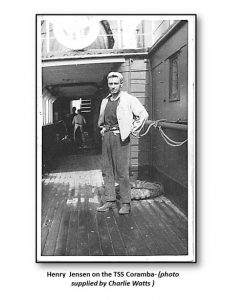

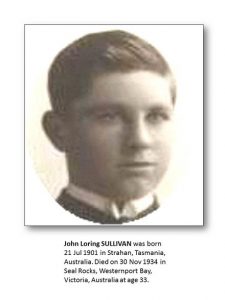
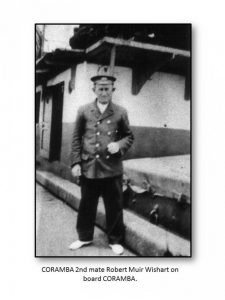


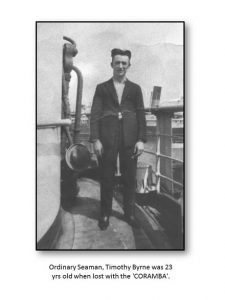

Historical Photos
Photos
The Research
The Coramba remained hidden under the sea for more than 77 years. To enable an effective search on water, considerable effort is first performed on land in researching the history and any other information that may provide some clue as to where the shipwreck is. From our investigations there is clearly a significant contradiction in the evidence that had been researched over the years. Firstly, Johnno Johnstone’s evidence at the marine board enquiry of the sinking clearly puts the location of the wreck to the east of Seal Rocks off shore from Kitty Miller Bay. However subsequent news reports, historical books, eyewitness accounts of the original search and local fisherman, place the wreck to the west and south west of Seal Rocks. Clearly both versions cannot be correct.From these varied reports the evidence of the ships location has been difficult to validate other than that there has been two main areas where the ship could possibly be, either east of Seal Rocks or to the west in the Western Port bay channel. Either position is separated by a distance of many kilometers and represented a huge search area.
Southern Ocean Exploration commenced searching for the Coramba on the eastern side of Seal Rocks in 2004. SOE also started searching the western side and had completed several search grids whilst another SOE team continued to search the eastern side. Eventually we moved all of the searching across to the east side based on further research and some hydrographic data that hinted at possible locations of the ship. During this time an official Shipwreck Reporting form was received by Heritage Victoria stating that the wreck was reported as discovered by a local diver from Rye (to the west of Seal Rocks) and we moved on to commit our time to other projects and subsequently found the SS Alert (2007) and SS Glenelg (2009). Skepticism grew as to the true discovery of the Coramba and we formed an opinion that it had not been found after all. Several years and many searches later we reviewed all of our available information (for the 50,000th time) and decided that our best efforts should be to the eastern side of Seal Rocks.Using our side scan sonar we had slowly and painstakingly “mowed the lawn” out on the eastern side and by process of elimination we continued to narrow down the search area. The final breakthrough came when Peter Taylor identified an interesting mark on an old hydrographic chart. The site was a significant distance away from all of our previous search areas and being well south of Seal Rocks we assumed if it was a wreck it would be another ship. Once this area was surveyed the excitement grew as the soundings showed a 3 – 4 metre structure on the bottom. As soon as the weather cleared SOE divers reached the site and confirmed that the TSS Coramba had finally been found.
Site Plan
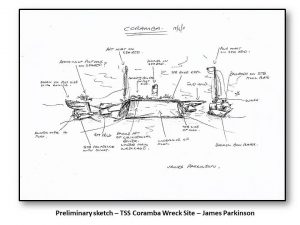
News and Events
Dive Pacific Magazine
Frankston Times June 2011
Charlie Wells – The Coffin Ship
TSS Coramba Found!
Westernport News
Mornington Leader
Portland Observer – June 17th 2011
Hobson Bay Leader – June 21st 2011
Ayrshire News, Scotland – July 1st 2011
Sunday Business Post, Ireland – 17th July 2011
Frankston Leader – 15th June 2011
Hobson Bay Leader – June 28th 2011
Acknowledgments
Greg Hodge – Founding Member.
Peter Taylor – Research Coordinator & Search Planning.
Martin Tozer – Researcher & Diver.
Mark Ryan – Team Leader, Video, Search & Dive Coordinator & Diver.
Jonathon Tandy – Boat Driver & Diver.
John Corby – Boat Driver & Diver.
Mick Whitmore – Boat Driver & Diver.
George Theodorovics- Diver.
Phill Carter – Diver.
Andrew Bennett – Diver.
Nick Schoeffler – Diver.
Brenden Stevenson – Diver.
Allan Easter – Boat Driver and Diver.
Chris Guthrie – Safety Diver.Other Supporters
Des Williams – Research.
Vikki Ryan – Diver.
Scott Fraser – Boat Driver & Diver.
John Karaglanis- Diver.
Jim Kolokithas – Diver.
Steve Cartlidge – Diver.
John Lawler – Boat Driver & diver.
Justin Mc Carthey – Boat Driver & diver.
Chris Edwards – Video & Diver.
Peter Lawrence – Diver.Whitewater Documentary Films
Terry Cantwell – Producer.
David Muir – Sound mixing.
Reference
In 1984 Des Williams authored the Book “The Ship the Sea Swallowed. This document contains details of the ships history and its sinking. Other resources used include The Board of Marine Inquiry. This file contains details of the official enquiry into the sinking. Additional information was also gathered from the National Archives, personal interviews and Newspapers.
The Ship the Sea Swallowed – Des Williams 1984
The Age November – December 1934.
The Argus November – December 1934.
John Oxley Museum NSWBureau of Meteorology Report On Weather in 1934
In Victoria, many of the heaviest rainfall events occur when a depression develops over the State within an existing moist airmass. The area around Melbourne experiences its heaviest falls when such an event occurs just to the east or southeast of Melbourne, producing strong south to southwesterly winds. Just such an event took place at the end of November 1934.
The spring of 1934 had been very wet, with frequent heavy rain and storms, when on 29 November an active cold front crossed Victoria, relieving sultry conditions. Quoting the 1974 Victorian Yearbook: “Some hours after the front, barometers fell rapidly as a depression developed in Bass Strait. The south-west wind strengthened overnight and in Melbourne blew with gale force for most of Friday 30 November.” Torrential rain began falling in central Victoria and Gippsland on Thursday night, and continued throughout Friday. In Melbourne, 140mm fell in the 48 hours ended 1 December, but rainfall was much heavier in the hills east of Melbourne – which comprises the catchment area for the Yarra River – and over South Gippsland. In these areas totals exceeded 350mm within 48 hours, isolating towns through numerous landslides, submerged roads, and washed-out bridges. Heavy rain also fell in northeastern Victoria, and cold air accompanying the storm resulted in heavy – and quite unseasonable – snowfalls on the higher mountains.The Yarra River, swollen by the torrents of water falling over its catchment, broke its banks, as did other metropolitan creeks and rivers. Many suburban areas were inundated, forcing residents to evacuate. In areas such as Moonee Ponds, in Melbourne’s west, such evacuations were not uncommon at that time; but in the eastern suburbs the flooding was easily the worst in the 20th century, and evacuations were necessary from some areas previously regarded as flood-free. Disastrous flooding was widespread over the Yarra Valley, South Gippsland, and the Latrobe River District, with major stock, crops and property losses. The damage was exacerbated by the gale force winds that accompanied the rain, causing heavy livestock losses through exposure, as well as much property damage. Very many trees were uprooted by the combination of high winds and sodden ground. In all, at least 36 deaths were attributed to the flood, and in Melbourne some 400 houses and factories were flooded.
The remainder of that summer, and also autumn 1935, was noteworthy for several other unusually heavy rain events in Victoria, a departure from the otherwise generally dry decade of the 1930s.
